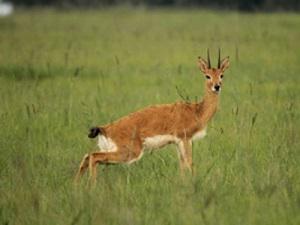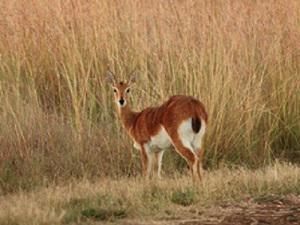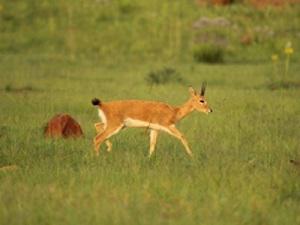Keenan Stears
The aim of the project is to determine how seasonal changes in grass quality, predation risk and interactions with domestic livestock determine oribi food selection and ultimately their movement and utilisation of the landscape.

The oribi (Ourebia ourebi) is listed in the South African Red Data Book as endangered (Friedmann and Daly, 2004). In KwaZulu-Natal, oribi occur in the mistbelt sourveld areas where food quality and availability decline drastically during winter. In order to meet their high daily energetic requirements they need to forage selectively on high quality grass. However, during winter, high quality grass is not readily available. I will determine how seasonal changes in grass quality influence small scale foraging decisions. Ultimately, this requires an understanding of the mechanisms behind the variation in seasonal food preference. For example, do oribi change their diet to obtain higher levels of crude protein? Or do they feed on grasses with lower crude fibre content or do they rather select grasses that are high in some other limiting resource or mineral such as phosphorous? To determine this, I will compare the nutritional status of the different grasses and grass parts that are consumed in relation to what is available.

Furthermore, a large portion of these areas are also home to domestic livestock. When there is an interaction between cattle and wildlife, there is a common belief that wildlife compete with cattle for food. Odadi et al. (2011) found that large wild herbivores have a competitive interaction with cattle during the dry season. However, in the wet season, wild herbivores had a facilitative influence on cattle performance. The problem is that there is little information on how cattle influence wild herbivores, especially small, very selective herbivores such as the oribi. The overall influence of the competitive/facilitative processes can then be compared to determine whether the presence of livestock has a long term positive or negative effect on oribi populations.

Predation risk is a key factor that influences foraging decisions (Lima, 1998; Brown and Kotler, 2004). Landscape features influence the likelihood of detecting predators in time as well as the probability of escape (Lima and Dill, 1990). Therefore foragers alter their use of space and foraging depending on the landscape. Viewing landscape in terms of predation risk is termed landscape of fear (Laundré et al., 2001) and topography, ambush sites and refuge sites can influence these landscapes. As a result, foragers may not feed uniformly across the landscape but rather prefer to feed in areas that they perceive to be safe. By using artificial feeding patches to measure giving up densities (GUDs), (i.e. the amount of food left in a patch after a forager has finished eating), it is possible to generate contours of perceived predation risk (van de Merwe, 2004). By mapping their landscape of fear, I will gain insight into how oribi utilise landscapes and thus provide valuable information with regard to the successful conservation of oribi. For example, this information can then be used to determine the optimal corridor width that oribi use to move between fragmented habitats.